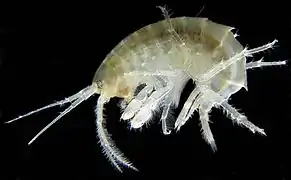Gammaridea
Les Gammaridea sont un sous-ordre de crustacés de l'ordre des amphipodes.
Ne doit pas être confondu avec Gammaridae.

| Règne | Animalia |
|---|---|
| Embranchement | Arthropoda |
| Sous-embr. | Crustacea |
| Classe | Malacostraca |
| Sous-classe | Eumalacostraca |
| Super-ordre | Peracarida |
| Ordre | Amphipoda |

sont essentiellement détritivores
Ce sous-ordre a été créé en 1802 par Pierre André Latreille.
Il contient environ 5 700 des 7 000 espèces d'amphipodes décrites à ce jour (environ 1 000 genres, répartis dans environ 125 familles).
Les Gammaridea comprennent presque toutes les espèces d'amphipodes vivant en eaux douces dont le Gammarus pulex, autrefois très commun en Europe et encore l'espèce la plus commune.
Systématique
|
Super-famille Ampeliscoidea
Super-famille Clarencioidea
Super-famille Crangonyctoidea
Super-famille Dexaminoidea
Super-famille Eusiroidea
Super-famille Gammaroidea
|
Super-famille Hadzioidea
Super-famille Iphimedioidea
Super-famille Kurioidea
Super-famille Leucothoidea
Super-famille Liljborgioidea
Super-famille Lysianassoidea
Super-famille Melphidippoidea
Super-famille Oedicerotoidea
Super-famille Pardaliscoidea
|
Super-famille Phoxocephaloidea
Super-famille Stegocephaloidea
Super-famille Stenothoidea
Super-famille Synopioidea
Super-famille Talitroidea - includes Phliantoidea
Incertae sedis (Classification incertaine)
|
Voir aussi
Liens externes
- (en) Gammaridea sur Fauna Europaea
- (fr+en) Référence ITIS : Gammaridea Latreille, 1802
- (en) Référence World Register of Marine Species : taxon Gammaridea Latreille, 1802 [non valide] (+ liste familles + liste genres)
Notes et références
- Lowry, J.K.& H.E.Stoddart 2002. The Amaryllidae of Australia (Crustacea: Amphipoda: Lysianassoidea). Records of the Australian Museum 54:129-214.
- Portail de la carcinologie et des crustacés